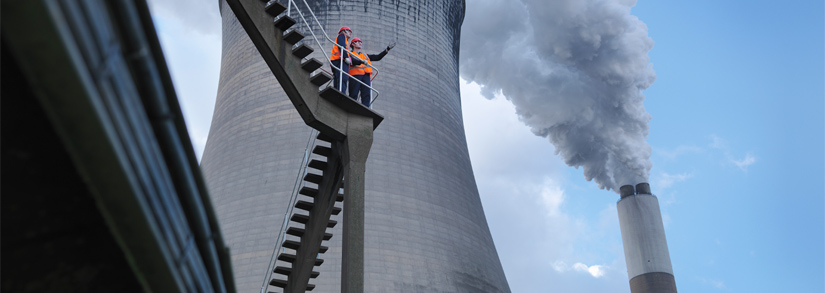
- In the near term, government responses to the war in Ukraine may lead to an increase in coal use and a resurgence of investment in fossil fuels in Europe, which may increase global greenhouse-gas emissions over the next five years.
- In the long term, delaying the shift toward cleaner sources of energy while remaining within a net-zero global emissions budget would require an accelerated shift later, according to science-based climate scenarios.
- We examined the financial risk of two scenarios for European firms and found that a “Delayed transition” scenario increased net downside risk by 17 times on average across sectors, with energy and materials facing the largest potential losses.
Europe’s desire to reduce its use of Russian gas in the wake of Russia’s invasion of Ukraine increases the likelihood that its use of coal will rise in the near future. A 10-point plan to “reduce the European Union’s reliance on Russian natural gas,” released by the International Energy Agency, suggested the region increase its use of coal and oil to generate electricity.1 Swapping coal for gas would increase the region’s greenhouse-gas (GHG) emissions by 2.45 times per kilowatt-hour of electricity generated.2
Europe’s search for stable sources of energy supply, however emission-intensive, may slow the pace of the low-carbon transition in the short term. However, to stay within a net-zero cumulative emissions budget, more short-term GHG emissions would have to mean fewer emissions later. As the exhibit below shows, the shape of the budget can shift, but the area under the curve cannot change.
What might a delayed (but then accelerated) transition mean for institutional investors’ portfolios?
European GHG emissions
Data as of March 18, 2022. Source: MSCI ESG Research LLC
Assessing the risk of a delayed transition
We used MSCI’s Climate Value-at-Risk (Climate VaR) metric to compare the financial risk for constituents of the MSCI Europe Investable Market Index (IMI) associated with two hypothetical climate scenarios.3 We analyzed a “Below 2°C” scenario, with a gradual rise in an implied carbon price through 2050 and beyond, and a “Delayed transition” scenario, where carbon prices rise sharply in the 2030s to spur a transition.4
While seemingly extreme, the “Delayed transition” scenario used here, with carbon prices rising above USD 400 per ton in the 2030s, may be indicative of the risks and opportunities of delaying climate action while ultimately remaining within a net-zero budget. Values are expressed as a percent change in the total value of equity.
Net transition Climate VaR in MSCI Europe IMI sectors
Data as of March 1, 2022. Source: MSCI ESG Research LLC
The exhibit above shows the resulting sectoral averages for net risk associated with (downside) policy risk, such as carbon-pricing mechanisms, and (upside) risk associated with potential opportunities for climate-solutions providers.
A few points from the analysis stood out:
- Potential losses increased by 17 times on average across sectors in the “Delayed transition” scenario compared to the “Below 2°C” scenario.
- The differences in net transition risk between the two scenarios were largest for the energy and materials sectors, with downside risk of 60% vs. 10% and 59% vs. 11%, respectively.
- Under the “Delayed transition” scenario, net transition risk for the communications-services, consumer-staples and consumer-discretionary sectors led to financial losses roughly 24, 17 and 12 times higher, respectively, compared to the “Below 2°C” scenario.
- The utilities and energy sectors had potentially large technology opportunities in a “Delayed transition” scenario (66% and 34%, respectively), though higher policy risk outweighed the opportunities (79% and 93%, respectively), for net downside risk.
Navigating volatility and uncertainty
This analysis looked specifically at Europe, given its reliance on Russian energy, but the question of increased risk applies elsewhere. In the U.S., for example, there may be renewed interest in fossil-fuel investments, given high prices and the fact that the Biden administration has so far been unable to pass legislation it considers key for climate mitigation. In an analogous analysis to the one for Europe, we found similar results between the two scenarios for constituents of the MSCI USA IMI.
Regardless of region, the past weeks have shown uncertainty and volatility to be market realities. While governments and market participants may make trade-offs between energy security and the pace of the climate transition in the short term, they will contend with the cumulative nature of the net-zero emissions budget, as Europe aims to shift away from Russian gas. Analyzing a range of scenarios, including climate-risk-related scenarios that show different decarbonization trajectories, can help investors quantify the potential impacts that changes in policy risk and technology opportunities may have on their portfolios.
1“A 10-Point Plan to Reduce the European Union’s Reliance on Russian Natural Gas.” International Energy Agency, March 3, 2022.
2“How much carbon dioxide is produced per kilowatthour of U.S. electricity generation?” U.S. Energy Information Administration.
3MSCI’s Climate Value-at-Risk (Climate VaR) is designed to provide a forward-looking and return-based valuation assessment to measure climate-related risks and opportunities in an investment portfolio. The MSCI Climate VaR model has three main components, which can be used separately or in aggregate: policy risk, technology opportunities and physical risks. The fully quantitative model offers insights into how climate change could affect company valuations providing a choice between different scenarios.
4MSCI Europe IMI constituents as of March 15, 2022. For more information on the Network for Greening the Financial System’s climate scenarios, see: “Scenarios Portal.” Network for Greening the Financial System.
